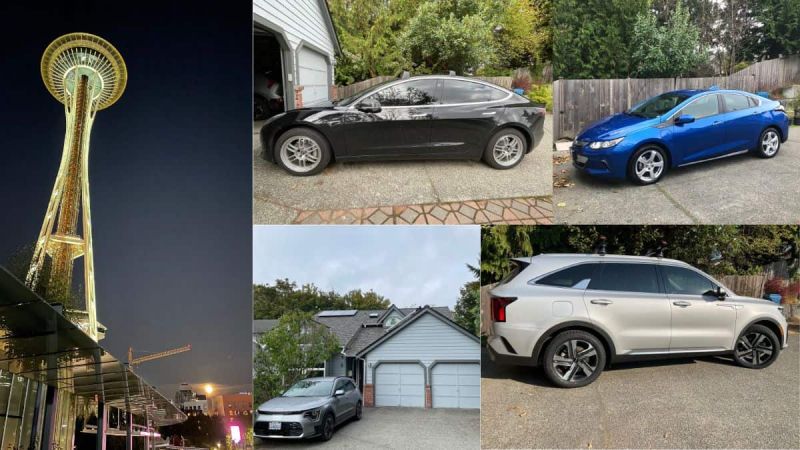First, let’s start with the numbers. For the year spanning the end of March 2023 to the end of March 2024, my solar array produced 7,970 kWh of electricity (slightly less than I previously estimated they would). For that same timeframe, my two plug-in vehicles consumed approximately 3,729 kWh (3,390 kWh worth of driving, with an estimated 10% penalty lost to charging inefficiency).
That total consumption fueled my two vehicles for 12,608 miles of emissions-free driving, a combined 3.7 miles per kWh (not bad considering one of those vehicles is a 3-row SUV). Now, to add some important clarifications. A
pproximately 838 kWh of that total was added to my two vehicles while on the road, at public charging locations or the homes of friends and family members, I visited during that time frame. Nearly all of those kWh were free to me (I did spend $55.40 at supercharges in that timeframe, on road trips in my Tesla Model 3) and I also covered about 4,750 miles (separate from the total of 12,608) using the gas engine in my larger plug-in vehicle, a Kia Sorento PHEV. That means I will subtract 3,102 miles of driving from my 12,608 total in terms of calculating what my home solar panels theoretically supplied to my vehicles (important simply in terms of calculating the “direct” cost my panels had on my house’s energy consumption, versus the people living in it).
That leaves me with 9,506 miles worth of annual travel I can more directly attribute to the solar panels on my roof. The remainder of the 5,400 or so kWh that my roof produced in that year either powered my household or went back to the grid.
For anyone that cares, that 5,400 kWh would work out to roughly half of the rest of my house’s annual electricity consumption (excluding the kWh consumed by my vehicles). For what it’s worth, if we lived in a sunnier location, for example the beautiful island of Kauai where I am writing this article from, then we might have produced an additional 1,800 kWh or so of electricity from our solar panels (a little more than 20% better).
I mention this because of course where one lives could significantly affect how much electricity a similar solar array could produce (not to mention the orientation and shade conditions that would also affect output).
In the Seattle area, electricity currently costs about 13 cents per kWh and gasoline currently costs north of $4.73 per gallon (for regular unleaded, on average) according to AAA.com. That means if you have an EV or PHEV that gets about the same miles per kWh as I have managed to achieve between one of each (about 3.7 miles per kWh) and you enjoy the relatively low cost of 13 cents per kWh, you will pay about 3.5 cents per mile to drive on electricity.
If you are only using gas to move your rig, the most recent national average fuel efficiency for light duty vehicles works out to 26.4 miles per gallon (MPG), or 33.3 MPG for passenger cars and 23.4 for light “trucks” according to the US Department of Energy.
If you lived in the Seattle area like me, that means you would pay about 18 cents per mile to drive a vehicle that gets the average MPG, or 14 cents per mile for a car/20 cents per mile for a light truck that runs on regular unleaded. At those rates, and at the distances we drove our cars for a year, that works out to roughly an annual difference of $1,816 for the 26.4 MPG figure, or $1,348 for a passenger car and $2,106 for a light truck. By difference, I am referring to the difference in cost between the number of gallons to drive 12,608 miles at the average MPG figures provided vs driving that distance paying the current electrical rate and covering 3.7 miles per kWh.
Strictly in terms of the savings I achieve from driving (and disregarding the cost savings for the rest of my home energy use) that works out to about 13 years for the fuel savings alone to cover the cost of the panels. Obviously, the savings for my home energy use would further reduce that timeframe (to about 9.5 years by my rough estimate).
If one lived in a sunnier location than the Seattle area, that would further increase the annual energy output/shorten the period of return. Given the 25 year minimum usable life (and there is very little doubt that their usable life is realistically 30-40 years), that absolutely confirms that yes, the juice is worth the squeeze.
Do you have questions or concerns about driving an EV or PHEV? Are you perhaps interested in getting solar on your roof/at your property to either directly power or offset your kWh consumed by driving? Please leave your questions and comments below.
Image courtesy of Justin Hart.
Justin Hart has owned and driven electric vehicles for over 15 years, including a first-generation Nissan LEAF, second-generation Chevy Volt, Tesla Model 3, an electric bicycle and most recently a Kia Sorento PHEV. He is also an avid SUP rider, poet, photographer and wine lover. He enjoys taking long EV and PHEV road trips to beautiful and serene places with the people he loves. Follow Justin on Torque News Kia or X for regular electric and hybrid news coverage.













Comments
I live north of Seattle…
Permalink
I live north of Seattle where they kept all the native growth trees. Solar is impossible because of tree cover. We grow moss instead of lawn.
That is definitely something…
Permalink
In reply to I live north of Seattle… by Dana Gilner (not verified)
That is definitely something I have experienced too (my previous home in the Seattle area had 21 mature Doug Firs on it). And being surrounded by so much green is also a treat in itself. Cheers!